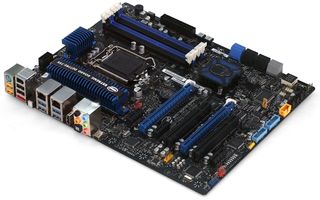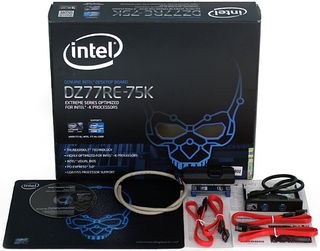Six $220-280 Z77 Express-Based Motherboards, Reviewed
Expanded graphics card support, enhanced on-board features that include Thunderbolt on some models, and more-robust voltage control are all good reasons to consider paying a little extra for a higher-end motherboard. Today we examine five top choices.
Intel DZ77RE-75K
Intel sent two versions of its high-end Z77 Express-based motherboard, with and without Thunderbolt technology. Unfortunately, we were only giving each vendor one slot each in today's story. After looking at the features its competitors offered, we decided to go with the Thunderbolt-equipped version.

In addition to a single Thunderbolt port, the rear I/O panel offers four USB 3.0, four USB 2.0, and FireWire ports, along with HDMI output and two interfaces to gigabit Ethernet controllers. On the other hand, all three of this board's x1 slots, both of its PCI slots, and its FireWire controller fight for the bandwidth of a single PCIe lane through a single-lane to multi-lane switch.
If overclocking causes the system to stop booting, pressing the Back to BIOS button will force the board to start up with factory settings without losing your custom configuration. The motherboard simply ignores the custom settings until the button is disengaged, allowing users to make minor corrections before trying again.

The reason that so many devices share so little bandwidth is that Intel dedicates most of the Z77 PCH's connectivity to its Thunderbolt controller. And, like Gigabyte, it reserves the CPU's PCI Express lanes for discrete graphics. You don't get a triple-card option. Instead, the x16/x0 lane configuration changes to x8/x8 when an add-in board drops into the second PCIe x16 slot.
Because the bottom PCI Express slot doesn't support a graphics card, we're less bothered by Intel's placement of the USB 3.0 header. On the board's bottom edge, both headers are horribly located. But most PCIe x1 cards are thin enough to prevent spatial conflicts.
Intel moves the DZ77RE-75K's front-panel audio connector up the board’s rear edge by three slot spaces, making it easier for short cables to reach, while simultaneously making finished builds look more cluttered (there’s no way to get the cable to the header without running it over the motherboard’s top).
Two Marvell SATA 6Gb/s controllers add one external and two internal ports to the six controlled by the chipset. All eight of the board’s internal SATA ports face forward to avoid conflicts with long cards, though some older case designs block access to forward-facing ports. Reading chassis reviews help avoid those kinds of problems, though.
Stay on the Cutting Edge
Join the experts who read Tom's Hardware for the inside track on enthusiast PC tech news — and have for over 25 years. We'll send breaking news and in-depth reviews of CPUs, GPUs, AI, maker hardware and more straight to your inbox.
A Port 80 diagnostics display and internal power/reset buttons help overclockers bench-test the DZ77RE-75K, but those features are far less valuable once you get the board installed inside an enclosure.

The DZ77RE-75K includes a mouse pad, four SATA cables, a USB 3.0-to-3.5” external bay adapter, an SLI bridge, and a USB 2.0-based Wi-Fi/Bluetooth module. The module is designed to adhere to the back of a solid plastic 5.25” bay cover.
Current page: Intel DZ77RE-75K
Prev Page GA-Z77X-UP5 TH Firmware Next Page DZ77RE-75K Software And Firmware-
roberta As u have reviewed SIX (6) motherboards, the article's title should be:Reply
"Six $220-280 Z77 Express-Based Motherboards, Reviewed" -
mayankleoboy1 No SATA and USB tests ? data transfer speed differences will typically be noticable in everyday usage.Reply
Also, the time taken to show the windows loading screen/ BIOS page.. -
admit it.Reply
you really liked the black/grey dimms and PCI slots of the gigabyte better than the blue/black of the MSI! -
Crashman robertaAs u have reviewed SIX (6) motherboards, the article's title should be:"Six $220-280 Z77 Express-Based Motherboards, Reviewed"Let's see what the article says:ReplyThe one motherboard in today’s line-up with a 48-lane PCIe 3.0 bridge is ECS’ Golden Z77H2-AX. Unfortunately, this platform climbed $40 beyond the budget limit of today’s round-up in the time we've been reviewing it. We're tired of seeing board vendors playing pricing games based on our review schedule (this isn't the first time we're seeing a curiously-timed price move). So, since we put the work in to review ECS' submission, we're including our already-gathered data and simply withholding the board from any award candidacy.
mayankleoboy1No SATA and USB tests ? data transfer speed differences will typically be noticable in everyday usage.Also, the time taken to show the windows loading screen/ BIOS page..Would have covered windows load time except that it wasn't markedly different. That is, after disabling empty SATA controllers. If you count the time that it takes to get the "No Device Found" error on boards that have extra SATA controllers, you're penalizing a board for having more features.
Andrew Ku tests drive controllers. I'm trying to get him to "write the book" on controller performance, since dozens of boards use only a few different controllers. As for testing things like Z77 controller performance on board A vs Z77 controller performance on board B, it's a waste of time unless something is broken. So the article looked for "broken stuff". See the red bar on the first chart:
http://www.tomshardware.com/reviews/z77x-up5-th-z77a-gd80-z77-oc-formula,3305-22.html
With nothing broken, there's no excuse to test the Z77 controller six times. Back to me begging Andrew Ku for a comprehensive comparison of every SATA controller currently available on mainstream-brand enthusiast boards.
-
JeanLuc Arghh! Why the hell are you overclocking the base clock on Z77!! That will most likely cause permanent damage to your CPU.Reply -
You left out a key aspect for overclockers which is vcore offset.Reply
This allows ocer's to achieve higher overclocks while still retaining the power saving functions, instead of being forced to either reduce the overclock, or be forced to run high voltage 24/7.
MSI doesn't have this key feature. -
Onus I would think that the Sabertooth's five year warranty merits at least a mention in any value conclusion.Reply
-
luciferano JeanLucArghh! Why the hell are you overclocking the base clock on Z77!! That will most likely cause permanent damage to your CPU.Reply
Overclocking the BLCK is very unlikely to cause any damage, it's just likely to not give much of a stable overclock. -
Crashman jtt283I would think that the Sabertooth's five year warranty merits at least a mention in any value conclusion.I actually missed that, having checked the lesser brands just to make sure those still had their three year warranty. Will add it.Reply
Most Popular


